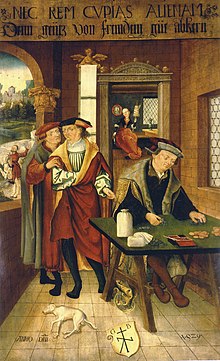Greger Byner
Greger (Gregor) Byner (also Byener, Gregorius Schneider ) was a Dresden councilor and mayor in the 16th century .
Life
origin
Nothing is known about Byner's origins. Apparently, however, he did not come from Dresden, as, according to a treasury invoice available in the council archives, he only acquired citizenship in 1499 against the payment of 59 groschen . Professionally he worked as a tailor. However, members of the family can be found in Dresden as early as 1437. The future mayor Peter Byner , who was a member of the council between 1528 and 1549 , also comes from here .
Act as councilor and mayor
From 1507 Greger Byner was a member of the council and, as pan master, was initially responsible for the allocation of the council's own brewing pans to the citizens entitled to brew and the fees to be paid to the city. The proceeds of the Pfannenamt were used for the purchase of new brewing equipment or went to the Maternihospital . In 1514 he also took over the management of the building department.
In 1518 Byner was elected mayor for the first time. The assumption of this office was initially only conditionally approved by the sovereign Georg the Bearded , who had wanted another candidate, but ultimately confirmed. According to the current council order of 1470, Byner remained in office in the usual three-year cycle until 1539. In 1540 he was mentioned for the last time in the council register.
Activity as bridge master
From 1524 to 1539 Greger Byner succeeded Donat Conrad bridge master. The bridge office was closely connected with the Kreuzkirche and received considerable income from property, but also from foundations and indulgences . These were used to preserve the stone bridge over the Elbe and were used to preserve and equip the Kreuzkirche. Extensive renovation and renovation work was carried out on the bridge during Byner's tenure. A bridge bill from 1534 shows, among other things, the demolition and construction of the bridge toll house on the Neudresdner (old town) side and the construction of a new gatehouse on the Altendresdner side.
Byner and the ten command plates of Hans the painter
The ten bid boards by an artist known under the name of Hans the painter , which are among the most important works of art of the early Renaissance in Dresden, are largely due to Byner's influence . The Dresden bidding cycle was created in 1528/29 and was once part of the interior of the Kreuzkirche. A bridge office invoice from this period shows the commissioning of the artist, who was probably a student of Lucas Cranach . Hans the painter received 9 shock and 27 groschen from the assets of the bridge office for his work. The clients were the then pastor of the Kreuzkirche Petrus Eisenberg and Mayor Greger Byner. The tenth and final bid table shows Greger Byner's initials G B and the family's coat of arms at the bottom of the picture . Since the symbol can also be found on the Strasbourg stonemasons' main hut, Byner's ancestors were probably stonemasons.
The mandatory tables were removed during Byner's tenure in 1539 with the introduction of the Reformation and are now in the Dresden City Museum .
literature
- Sieglinde Richter-Nickel: The venerable council of Dresden , in: Dresdner Geschichtsbuch No. 5, Dresden City Museum (ed.); DZA Verlag for Culture and Science, Altenburg 1999, ISBN 3-9806602-1-4 .
- Otto Richter : Constitutional and administrative history of the city of Dresden , Volume 1, Verlag W. Baensch, Dresden 1885.
Individual evidence
- ^ Heinrich Butte: History of Dresden up to the Reformation time . In: Central German Research . Volume 54, Böhlau Verlag, 1967, p. 218
- ^ Martin Bernhard Lindau: History of the capital and residence city of Dresden , Volume 1, Verlag R. Kuntze, 1859, p. 396.
- ^ Wilhelm Schäfer: Chronicle of the Dresden Elbbrücke, together with the annals of the greatest Elbe floods from the earliest to the most recent times . Adler & Dietze, Dresden 1848, p. 39 ( digitized in Google book search).
- ^ Max Eckardt: The Biener-Bienert coats of arms 1529 to 1868 , special print from Der deutsche Herold , Dresden, 1909.
- ↑ Arndt Lorenz: Inconvenient Bildwerk. The ten mandatory tables from Hans the painter , in: Dresden History Book No. 10, Dresden City Museum (ed.); DZA Verlag for Culture and Science, Altenburg 2004, ISBN 3-936300-17-8 .
| predecessor | Office | successor |
|---|---|---|
| Martin Schreyer (1517) Hans Hanstein (1520, 1523) Hans Gleinig (1526, 1529, 1532, 1535, 1538) |
Mayor of Dresden 1518 , 1521 , 1524 , 1527 , 1530 , 1533 , 1536 , 1539 |
Donat Conrad (1519, 1522) Wenceslaus Nawmann (1525, 1528) Peter Byner (1531, 1534, 1537, 1540) |
| personal data | |
|---|---|
| SURNAME | Byner, Greger |
| ALTERNATIVE NAMES | Byner, Gregor; Byener, Gregor |
| BRIEF DESCRIPTION | Dresden councilor and mayor |
| DATE OF BIRTH | before 1499 |
| DATE OF DEATH | after 1539 |

